 |
| The Start of Student Mobilization |
| In 1938, the Ministry of Education issued its Matters Pertaining to Performance of Group Labor, which launched student labor programs for a certain number of days during summer vacation. In August 1941, the Student Corps, modeled on a military unit, formally organized students and teachers to join in the war effort. In 1944, the Outline of Student Mobilization based on the Outline of Extreme Measures for the Decisive Battle expanded mobilization to a year-round program. Across the country, groups of students were ordered to work at munitions plants. |
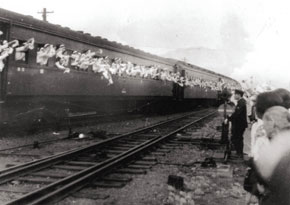 6/Female students leaving for mobilization worksites June 30, 1944 Bingo-tokaichi Station (Miyoshi Station) Photo by Torao Miyawaki Courtesy of Reiko Shinso |
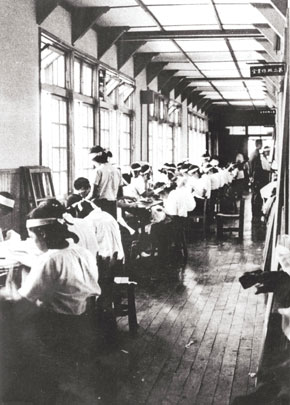 7/Schools become factories Photo by Kesatari Kawakami Courtesy of Kiyoshi Kawakami In addition to assigning students to factories, some schools were actually used as factories. School buildings and other facilities were converted for production. At technical schools, which had their own production equipment, classrooms simply became military factories. The sewing machines at girls' schools were used to sew military uniforms. | |
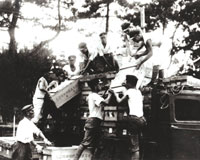 8/Students mobilized to work at the Hiroshima Army Ordnance Supply Depot About 1943 Hiroshima Army Ordnance Supply Depot Photo by Hiroshi Yano Courtesy of Cultural Affairs Division, Culture and Sports Department, Citizens' Affairs Bureau, Hiroshima City |
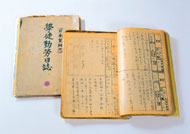 |
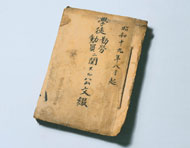 |
 |
||
|
9/Journals of students mobilized from First Municipal Girls' High School Right: Journal of mobilization at Japan Steel Works June - October 1944 Left: Journal of mobilization at Seibu Textiles June 1944 - April 1945 Courtesy of Hiroshima Municipal Funairi High School These journals were written by teachers to inform their schools regarding the mobilization situation. The girls assigned to the Japan Steel factory were making bullets. At the Seibu Textile factory they were making uniforms. Work began at 7:30 a.m. and continued until 5:00 p.m. In addition to articles about ongoing tasks, specific situations were reported occasionally that indicated the girls' devotion to their jobs. |
10/Loose-leaf file of notices on student labor mobilization at Senda National School
Courtesy of Hiroshima Municipal Senda Elementary School A file of notices from the prefecture regarding student mobilization during the 1944 school year. In July 1944, a notice entitled "Strengthening Student Labor," extended eligibility for mobilization to the upper level of national school and first and second years of secondary school. Mandatory overtime and night shifts were approved for newly mobilized students and those in the third year of secondary school and older. |
11/Ledger of payments to mobilized students at Yasuda Girls' High School FY 1945
Courtesy of Yasuda Educational Foundation Students received no explanations from their schools or workplaces regarding wages or working conditions, but national regulations stipulated that, for example, a secondary school student was to be paid 25 yen per month. However, the wages were not paid directly to the students. A lump sum was paid to the school based on the collective achievement of a given school's working students. This payment was distributed to the students after deductions for tuition and other fees. |
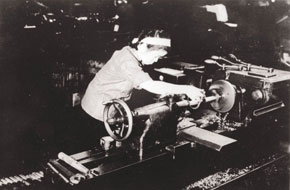 12/Dangerous tasks 1945 Toyo Kogyo Co., Ltd. Courtesy of Yoshie Ishikawa With a minimum of training, students were forced to handle difficult machines. Many were badly injured by the lathes used to make airplane parts. Sometimes the loads students were transporting fell on them. In addition to injuries, severe working conditions caused many illnesses. This photo shows a student from Hiroshima Girls' Commercial School using lathes at Toyo Kogyo Co., Ltd. |
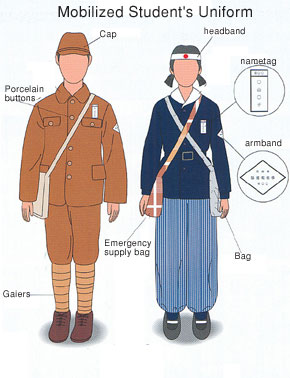 |
||
 |
13/Kamikaze headband Donated by Yasuji Fukuda A headband for a mobilized student to wear while working at an airplane factory. |
||
 |
14/Mobilized student's nametag and armband
Courtesy of the Committee to Remember the Dead of Yamanaka Girls' High School attached to Hiroshima Women's Higher School of Education A nametag, armband and school emblems worn by students at Yamanaka Girls' High School. The detailed regulations governing mobilized students stipulated, "Mobilized students shall wear tags identifying them as members of the Student Corps." Thus, it was mandatory to wear the designated nametag and armband when working. |
||
|
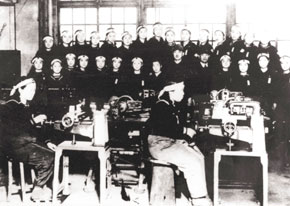 16/Graduating in a factory March 1945 Koa Sewing Machine Needle Manufacturing Plant Courtesy of Yasuda Educational Foundation During the war, graduation ceremonies were often held in schools and mobilization workplaces. After graduating, absent a special reason (illness or transferring to another school), students would go on to schools where requirements for their majors and minors would be relaxed to allow mobilization assignments to continue. This graduation photo shows students at Yasuda Girls' High School mobilized to work at Koa Sewing Machine Needle Manufacturing Plant. |
15/Illness and Injury among Girls' Students This chart shows the incidence of illnesses and accidents among mobilized students at Hiroshima Girls' High School for Home Economics and Yasuda Girls' High School from July 1 to September 30, 1944. The 249 students mobilized reported a total of 303 incidents of illness or injury. Clearly, mobilization adversely impacted the students' health. Source: History of Yasuda Educational Foundation—40th Anniversary—, Editors of History of Yasuda Educational Foundation—40th Anniversary—; Representative: Yoshio Chaen, 1955 |
|||||||||||||||||||||||||||||||||||||||||||||||||||||||||||||||||||||||||||||
| Mobilized Students -The Lost Tomorrows of the Students- Introduction Schools Stained the Color of War The Start of Student Mobilization Building Demolition Amplified the Tragedy The Suffering of Mobilized Students Looking for Children Reopening in the Burnt Ruins Monuments to the Students Return to TOP |